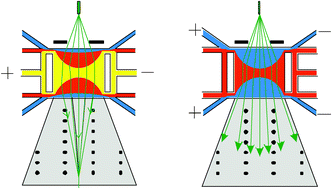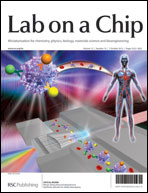An electrokinetically tunable optofluidic bi-concave lens†
Abstract
This paper numerically and experimentally investigates and demonstrates the design of an optofluidic in-plane bi-concave lens to perform both light focusing and diverging using the combined effect of pressure driven flow and electro-osmosis. The concave lens is formed in a rectangular chamber with a liquid core-liquid cladding (L2) configuration. Under constant flow rates, the performance of the lens can be controlled by an external electric field. The lens consists of a core stream (conducting fluid), cladding streams (non-conducing fluids), and auxiliary cladding streams (conducting fluids). In the focusing mode, the auxiliary cladding stream is introduced to sandwich the biconcave lens to prevent light rays from scattering at the rough chamber wall. In the diverging mode, the auxiliary cladding liquid has a new role as the low refractive-index cladding of the lens. In the experiments, the test devices were fabricated in polydimethylsiloxane (PDMS) using the standard soft lithography technique.


 Please wait while we load your content...
Please wait while we load your content...